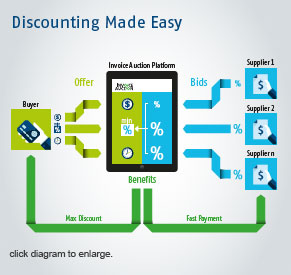OTHER INFORMATION / How it Compares
InvoiceAuction brings change.
Consider the following differences
Discounting: Discounting, both, in it’s standard way or in it’s „dynamic“ version, boils down to bilaterally (pre-)negotiated agreements. Such bilateral agreements are themselves quite costly to process internally for Buyers. Moreover, it is more difficult for a Buyer to apply a systematic approach to discounting. InvoiceAuction, in contrast, reduces the uncertainty surrounding the timing and amount of payments. Even so-called „dynamic discounting“ foregoes the benefits of InvoiceAuction’s „mark-to-market“ discounting model, which invites Suppliers to offer the discounts they are actually willing to give in any given situation.
Factoring: Whether done by financing the Suppliers or a Buyer, factoring introduces third parties into the business relationship of Buyer and Supplier. It thereby adds enormous administrative burden to the supplier chain involved. In addition, it is not calibrated to the actual financing needs of the parties involved, but rather adopts a „one-size-fits-all“ approach by assigning all available invoices, present and future, to the factor. This way, the factor imposes his cross-subsidizing-calculation on the Supplier instead of tailoring his offer to the true financial needs of it.
Secured Lending: Banks may bridge financing needs of a Supplier by lending against collateral, often including claims underlying invoices, thereby introducing a third party to the business relationship with its own administrative requirements and information needs. Again, the costs of this „one-size-fits-all“-approach to the Supplier are huge. In addition, lending is based on a Supplier’s credit rating instead of being linked to the Buyer’s risk.
